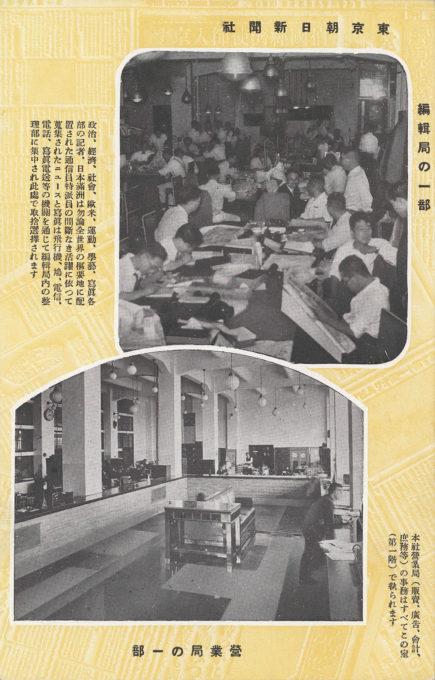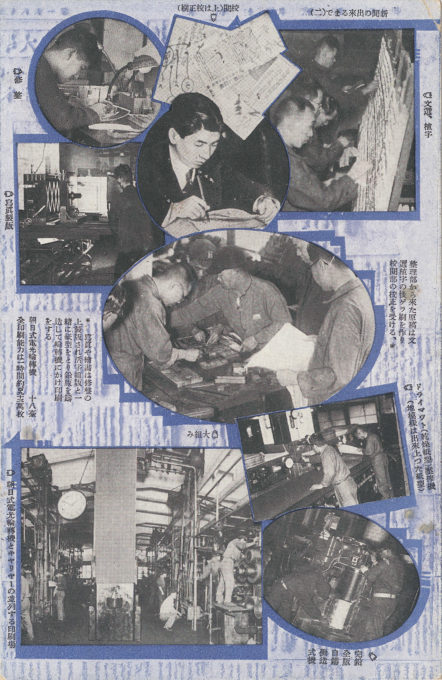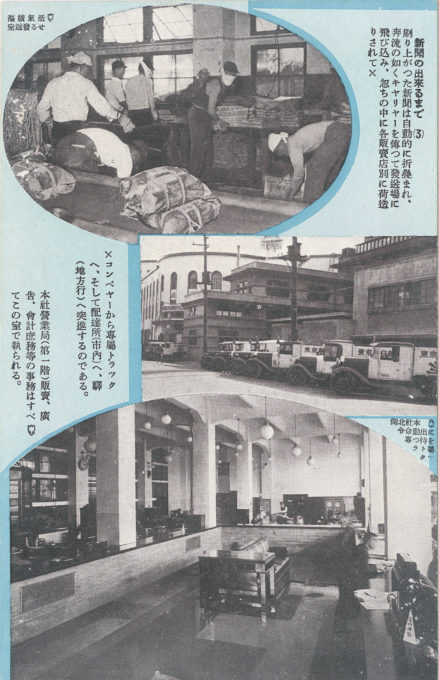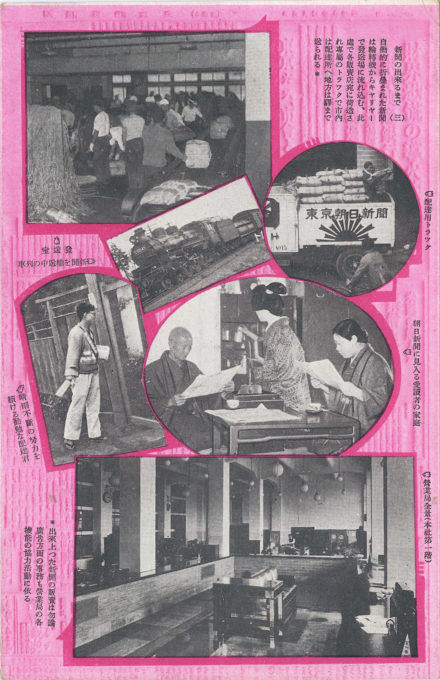The Asahi Shimbun was founded in 1879 as a small Osaka publication, but quickly rose in prominence as a source of news and literature. In 1888, its operations were expanded into Tokyo with the incorporation of the Tokyo Asahi Shimbun.
In 1908 the two newspapers merged to form a single corporate entity but still published separate daily editions in the two cities. This continued until 1940 after which the two newspapers published together as Asahi Shimbun.
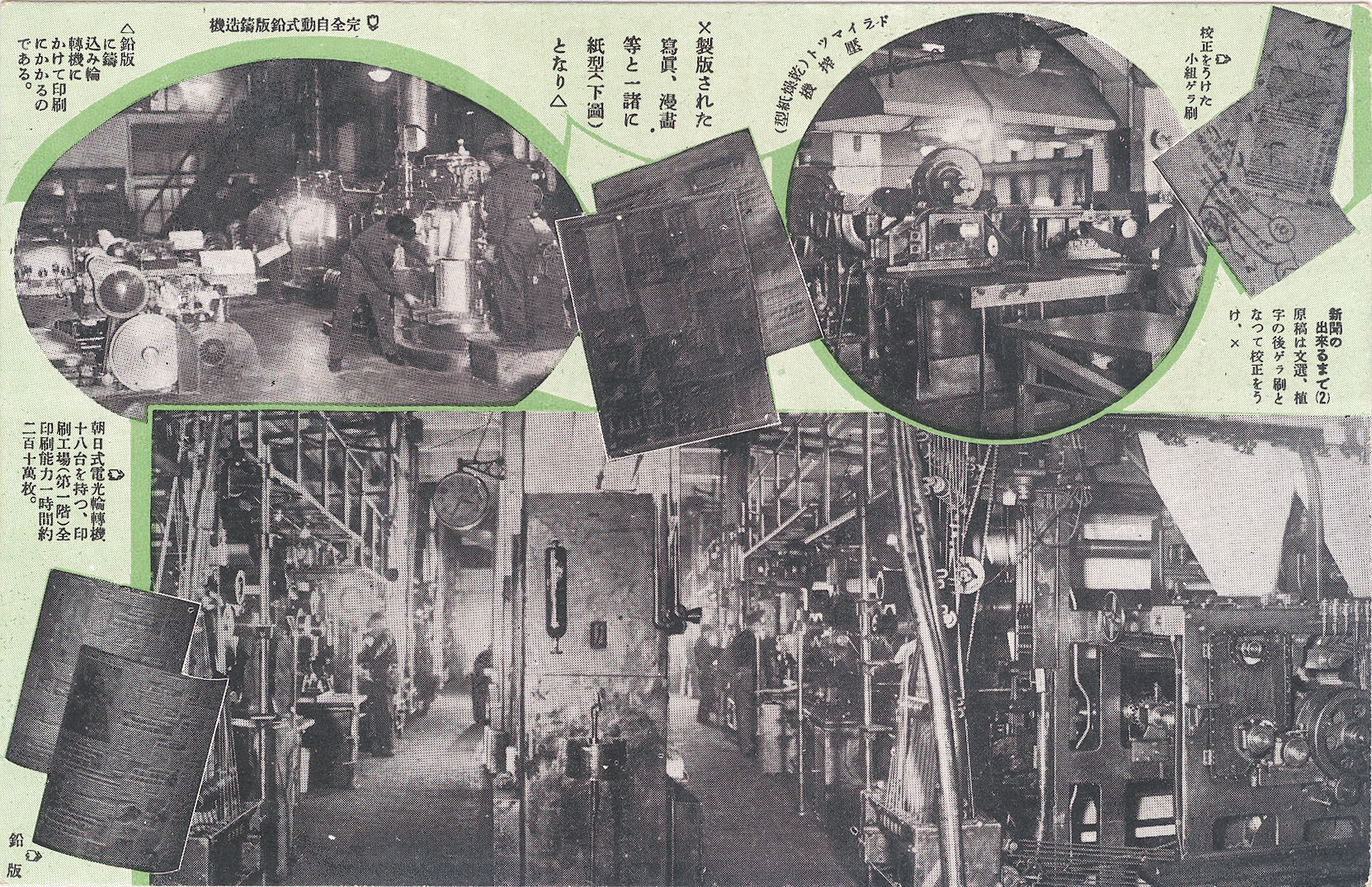
“How Newspapers Come to Be”, Tokyo Asahi Shimbun operations postcard series, c. 1935. The newspaper’s large printing press operations. Asahi Shimbun’s first-floor printing plant was capable of printing approximately 210,000 sheets per hour on each of its 18 rotary printing presses.
See also:
Tokyo Nichi Nichi Shimbun (Newspaper), Yurakucho, c. 1930.
Comparisons of Daily Newspaper Circulations, Worldwide, c. 1930.
“Japan, a nation of 65,000,000 souls in an area about the size of California, boasts almost 100 per cent literacy. Daily papers total 1,214 (the United States has approximately 2,600) and hardly a household is without one or more periodicals.
“How Newspapers Come to Be”, Asahi Shimbun operations postcard series, c. 1935. “Political, economic, social, British-American, athletic, academic, and artistic correspondents are stationed in key locations around the world as well as in Japan and Manchuria. (Lower photo:) All the head office operations (sales, marketing, accounting, general affairs, etc.) are handled in this 1st floor office.”
“[The] four big papers — two in Tokyo and two in Osaka — account for 4,000,000 of the nation’s daily circulation … The Tokyo Asahi and the Osaka Asahi have combined circulation of more than 2,000,000. The Tokyo Nichi Nichi and the Osaka Mainichi total 1,800,000. Their nearest competitor is the Tokyo Yomiuri, with 950,000. The most important provincial papers rarely exceed 50,000.
“… The Asahi chain in typical. The Osaka paper was organized in 1879 by two prosperous fancy goods merchants. Nine years later they entered the Tokyo field by buying up a small paper there and renaming it the Asahi (morning sun).
“The chain was the first to utilize the telegraph — then new to Japan — in news gathering. Publication in full of an Imperial Edict, sent from Tokyo to Osaka by wire, ‘scooped’ all of Western Japan and firmly established the Asahi’s reputation. In 1890 the Asahi installed the first rotary press in Japan.
“Typical of the early promotional stunts was the Asahi’s entry into Tokyo. Free rides on the city bus system were given to everyone carrying a copy of the new paper. Since that day the Asahi’s circulation has never been topped.
“Today the chain is almost universal in scope. In addition to the daily newspapers, it publishes more than a dozen other periodicals — weekly magazines, movie magazines, a children’s paper, a weekly for women, an annual review of the news, sports journals, an economic annual, a photo magazine in English and an annual in English. For libraries, it supplies photographically reduced reproductions of its papers.
“The Asahi papers have correspondents in many parts of the world, and its coverage of the Far East is phenomenal … In its news-gathering activities the chain makes extensive use of modern communications. Wired photo facilities are used within Japan, and to speed photos from the continent, an impressive fleet of fast planes operate. One of this group, the Kamikaze or ‘Divine Wind‘, established a Tokyo-London speed record in 1937.
“How Newspapers Come to Be”, Asahi Shimbun operations postcard series, c. 1935. “Thanks to the constant efforts of the communications department staff stationed in key locations around the world, the large number of photos, films, and other materials are collected and sent to the newspaper by airline, telephone, and fax! The media are delivered to the editing bureau’s internal organization department where they are sorted and selected.”
“… The Asahi chain is traditionally a strong supporter of liberalism. Even today, although its wings have been considerably trimmed by government decrees, it manages to retain some of its old crusading spirit. Consequently, the papers have a strong hold on Japanese intellectuals.
“… The physical difficultly of establishing a newspaper in Japanese is an important factor in journalism. Whereas the New York Times averages about 54 pages a day, with a comparable staff the Tokyo Asahi publishes only 12 pages.
“At every step the complicated written language is a handicap. The reporter who gets the story must write it out by hand, since Japanese typewriters are too cumbersom for general use. He tries to use only the 1,300 ideographs that are best known, but often it is necessary to go beyond this line. Then, if he is outside Tokyo, the reporter must telegraph his story to the paper. First it must be converted into phonetic kana characters, and on arrival at the news room it must be returned to its original form.
“The edited story is rushed to the composing room to be set in type. Instead of being done by one man at linotype machine, however, several must take parts and run up and down long type cases, setting the story entirely by hand. All this is done almost automatically, of course, but the lost motion involved in getting out a paper in Japan is discouraging. [But] once the type is selected and set, publication is by ultra-modern methods.”
– “Modern Journalism in the Eastern Manner”, Japanese Chamber of Commerce (New York), Far Eastern Trade, Fall 1940
- “How Newspapers Come to Be”, Asahi Shimbun operations postcard series, c. 1935. “Manuscripts are typeset, printed, and proofread by the proofreading department. Lead plates are made and affixed to the printing press. Each of Asahi’s 18 rotary presses have a capacity of 1,930,000 impressions per hour.”
- “How Newspapers Come to Be”, Asahi Shimbun operations postcard series, c. 1935. “Four evening editions, nine morning editions, 340 local editions, and three Tokyo editions are distributed to 6,000 dealers throughout the country by 30 trucks dedicated to the company. The newspapers are sent out one after another.”
- “How Newspapers Come to Be”, Asahi Shimbun operations postcard series, c. 1935. “The newspaper is automatically folded and rushes through the warehouse, where it is packed and delivered to the distributors.”
- “How Newspapers Come to Be”, Asahi Shimbun operations postcard series, c. 1935. “The bundled newspapers are loaded in the shipping yard from where they begin their by trucks to distribution stations in the city and the countryside. Newspaper sales depend on the cooperation of all the departments at Asashi Shimbun.”


